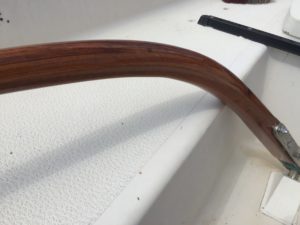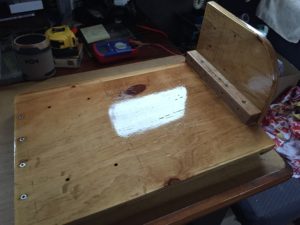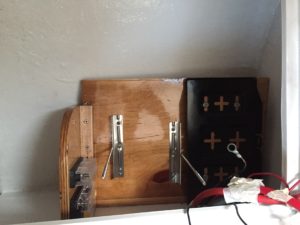The Dark Arts
Now that we are well into the journey of owning and restoring an old sailboat, it didn’t take long to realise that some parts of boat fixing come into the category of “dark arts”. Whilst a lot of jobs on the boat are pretty straight forward, albeit taking double the amount of time scheduled, and sometimes leading onto other jobs, or double the cost originally estimated, these jobs are run-of-the-mill stuff. It is a boat after all and things always take longer and cost more. What I really mean by dark arts, are those jobs that no matter what you do, or how much care, effort and planning go into them, they never seem to go right and often take several attempts, and you never even come close to getting a satisfactory result.
Surprisingly, the dark arts don’t comprise what you think they might. Take engines for instance. Oh I suppose that diesel engines can be considered mysterious objects and operate under laws known only to mystical mechanics or wizards, but actually it’s not the case. Marine diesels are fairly logical things and can be problem solved quite easily, even more easy than their petrol powered rivals. For example, if the engine doesn’t want to start, there can only be two reasons why, either no fuel or mechanical. Thus the problem solving flow chart starts. Certainly, more modern marine diesels can be complex but are not totally mystifying. The Yanmar YSE8 in La Mouette is quite a simple piece of machinery, whilst the common rail diesel in my Land Rover is a complex beastie with loads of electrical and computerised components. It certainly helps that I have spent a lot of time over the years playing with motorbike engines.
Similarly, with electrical systems. The electrics on La Mouette are fairly simple and although at first they seemed quite mystifying, after a lot of research into marine electrical systems, I broke through the barrier and was able to understand how it all fitted together. A larger boat with more systems will be more complex, but after cutting my teeth on our simple system, I have no doubts that tackling the electrics on a bigger boat will not be as difficult as it first seems.
So, if Professor Severus Snape was to teach the dark arts class at the Hogwarts Sailing Academy, what subjects would he be teaching? Varnishing would be one for a start. I have varnished a few pieces of woodwork aboard La Mouette with varying degrees of success. I might add that I have no experience of actually applying varnish but have had a bit at sanding woodwork etc. It seems to be the actual application that is the dark side of varnishing. Trying to get a perfectly smooth, mirror finish without any blemishes is the problem. Bubbles, dust, brushstrokes and runs galore on each coat. I have found that thinning the varnish definitely helps, but getting the varnish on the bit of wood without blemishes is darn near impossible. When we had the tiller fixed, the shipwright gave it a couple of coats of epoxy and we applied the varnish ourselves. The first coat took about a fortnight to try, as did the second coat. Subsequent coats wrinkled up and ended up being sanded off. A phone call to the varnish manufacturer didn’t help as they hadn’t heard of their product wrinkling up the way it did. If the manufacturer can’t help, what chance have I got? However, despite the difficulties, the repaired and varnished tiller looked really good but varnishing is definitely a subject for Professor Snape.

Cutting out pieces of wood with any fair degree of accuracy is another dark art. La Mouette needs new washboards and I have already had one go at cutting out new boards from a piece of marine ply. Trying to get the shape right and then sand it down so it’s an exact copy of the original is definitely in the category of voodoo magic. Admittedly, the jigsaw I was using was a piece of junk and making up a cardboard template from the original washboards and then using the cardboard template to transfer the shape to the marine ply seemed a good idea at the time but the variations multiplied each time. The marine ply version of the butterfly effect. Time for Professor Snape to don his woodworking apron.
Whilst on the subject of woodworking, trying to get the shape of the hull onto bits of wood is also a dark art. ie making up a bracket sort of thing that fits to the shape of the hull (on the inside of the boat of course). I tried making a template from pieces of cardboard and cut off bits of the cardboard to try and get the shape of the hull but just ended up with a pile of chopped up cardboard. It appears that you don’t attack your cardboard or paper template with scissors to try and get the shape. I wonder how it’s done. Maybe Dr Google can help out.
When the old batteries expired and needed replacing, I bought new batteries with more amp hours which meant bigger batteries, necessitating a larger and sturdier battery tray. I cut up an old ply wood television cabinet and fashioned up a tray that fitting nicely under the port quarter berth. It wouldn’t win awards but I was quite proud of it – even if a close examination revealed a few gaps here and there. But it was solid and would do the job. I originally intended to paint it white but after a few coats of epoxy sealing resin, it didn’t look half bad, so I sanded it and put on a couple of coats of varnish. As it was a recycled TV cabinet and not marine ply, the epoxy and varnish would seal it nicely. On retrospect, I could have made it a bit longer with a bigger side panel to bolt more electrical componentry to it and a bit more room for replacing fuses if needed.


There seems to be a trend happening here. Stuff involving wood and timber are in the category of dark arts whilst everything else is quite manageable even though a bit of work and research is involved. Fibreglassing and splicing have been undertaken with quite pleasing results, even though it’s still early days. However, after lots more work and practice, I have no doubt that even the mysteries of timber will be revealed and not so much with tuition from Professor Snape, but more so from our good friend Doctor Google. Where would we be without him? What’s the next project on La Mouette? Well the teak rub rail repairs have been done but the winch clean and regrease is still waiting, but more on that next time.